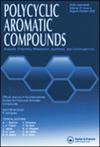Synthesis of Functionalized Isoxazolines as New Acetylcholinesterase and Tyrosinase Inhibitors and Antioxidant Agents
IF 2.6
3区 化学
Q2 CHEMISTRY, ORGANIC
引用次数: 0
Abstract
In the search for new leads capable of interacting with multiple targets involved in NDD pathogenesis, a series of pyrazine-linked isoxazoline scaffolds were designed, synthesized and evaluated for their acetylcholinesterase and tyrosinase inhibitory potency and antioxidant activity. Isoxazolines 4a, 4d and 4h exhibited better molecular interaction with cholinesterases, tyrosinases and peroxiredoxin enzymes. Isoxazolines 4a, 4d and 4h interacted with acetylcholinesterase with the highest docking score of −9.083, −8.68 and −7.87 kcal/mol, respectively. Compound 4h ranked top when interacting with butyrylcholinesterase with a docking score of −7.926 kcal/mol, followed by 4a (−6.327 kcal/mol). 4a exhibited a robust interaction with 1HD2 with a docking score of −3.103 kcal/mol followed by 4d and 4h. 4a, 4d and 4h exhibited better docking scores of −5.47 kcal/mol, −4.63 kcal/mol and −5.157 kcal/mol with the enzyme tyrosinase. Based on the in-silico data, we have proceeded further to synthesis and in-vitro studies. Chalcones were synthesized by the Claisen-Schmidt reaction, which was cyclised to isoxazolines by the cycloaddition of hydroxylamine HCl. FTIR, 1HNMR, 13CNMR, and mass spectral studies further characterized the compounds. The prediction of pharmacokinetic parameters also supports the study, and all the compounds passed the screening. In-vitro studies were performed to evaluate acetylcholinesterase and tyrosinase inhibition. Compound 4h displayed excellent action against acetylcholinesterases and tyrosinase enzymes. Hydrogen peroxide assay determined the antioxidant effect, which found that 4h and 4d compounds exhibited higher strength as peroxide scavengers. Thus, the study shows that pyrazine-based isoxazolines with electron-withdrawing groups can be used as leads to develop a drug of choice for NDD, as it has excellent acetylcholinesterase and tyrosinase inhibitory action and tremendous peroxide scavenging effect.
作为新型乙酰胆碱酯酶和酪氨酸酶抑制剂及抗氧化剂的功能化异噁唑啉的合成
为了寻找能够与涉及 NDD 发病机制的多个靶点相互作用的新线索,我们设计、合成并评估了一系列吡嗪连接的异噁唑啉支架对乙酰胆碱酯酶和酪氨酸酶的抑制效力和抗氧化活性。异噁唑啉 4a、4d 和 4h 与胆碱酯酶、酪氨酸酶和过氧化还原酶具有较好的分子相互作用。异噁唑啉 4a、4d 和 4h 与乙酰胆碱酯酶的对接得分最高,分别为 -9.083、-8.68 和 -7.87kcal/mol。化合物 4h 与丁酰胆碱酯酶的对接得分最高,为 -7.926 kcal/mol,其次是 4a(-6.327 kcal/mol)。4a 与 1HD2 具有很强的相互作用,对接得分为 -3.103 kcal/mol,其次是 4d 和 4h。4a、4d 和 4h 与酪氨酸酶的对接得分分别为 -5.47 kcal/mol、-4.63 kcal/mol 和 -5.157 kcal/mol。根据室内数据,我们进一步进行了合成和体外研究。查耳酮是通过克莱森-施密特反应合成的,然后通过盐酸羟胺的环化反应合成异噁唑啉。傅立叶变换红外光谱、1HNMR、13CNMR 和质谱研究进一步确定了这些化合物的特征。药代动力学参数的预测也为研究提供了支持,所有化合物都通过了筛选。体外研究评估了乙酰胆碱酯酶和酪氨酸酶的抑制作用。化合物 4h 对乙酰胆碱酯酶和酪氨酸酶有很好的抑制作用。过氧化氢检测确定了化合物的抗氧化作用,结果发现 4h 和 4d 化合物具有更强的过氧化物清除能力。因此,该研究表明,吡嗪基异恶唑类化合物具有良好的乙酰胆碱酯酶和酪氨酸酶抑制作用以及巨大的过氧化物清除作用,可以作为开发治疗 NDD 首选药物的线索。
本文章由计算机程序翻译,如有差异,请以英文原文为准。
求助全文
约1分钟内获得全文
求助全文
来源期刊

Polycyclic Aromatic Compounds
化学-有机化学
CiteScore
3.70
自引率
20.80%
发文量
412
审稿时长
3 months
期刊介绍:
The purpose of Polycyclic Aromatic Compounds is to provide an international and interdisciplinary forum for all aspects of research related to polycyclic aromatic compounds (PAC). Topics range from fundamental research in chemistry (including synthetic and theoretical chemistry) and physics (including astrophysics), as well as thermodynamics, spectroscopy, analytical methods, and biology to applied studies in environmental science, biochemistry, toxicology, and industry. Polycyclic Aromatic Compounds has an outstanding Editorial Board and offers a rapid and efficient peer review process, as well as a flexible open access policy.
 求助内容:
求助内容: 应助结果提醒方式:
应助结果提醒方式:


